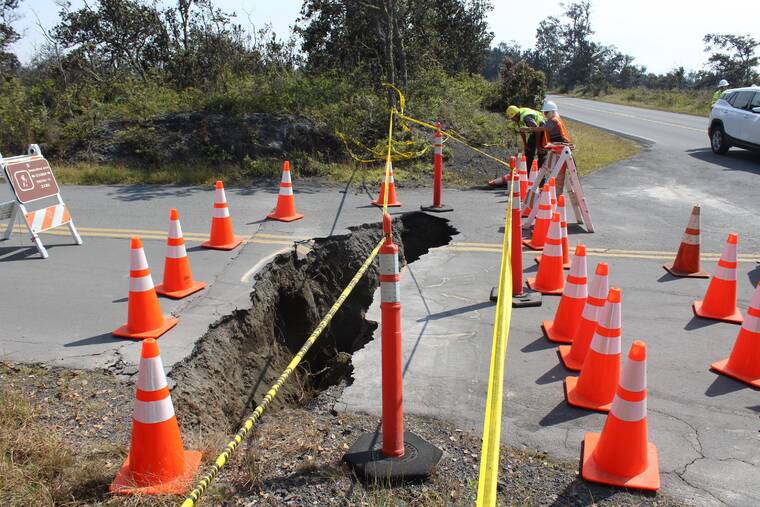Hawaii Volcanoes National Park has opened a comment period for community feedback about an environmental assessment for its proposed disaster recovery project to repair damage caused by the 2018 volcanic eruption and summit collapse on Kilauea volcano.
The comment period runs through 7:59 p.m. on July 31, and virtual public meetings will be held at noon and 6 p.m. on July 21.
The meetings will be available on Zoom at https://swca.zoom.us/j/93007408720. Those without internet access can join by phone at (888) 475-4499 toll-free in the U.S. The meeting ID is 930 0740 8720.
The focus of the project is to repair, replace, relocate or remove critical park infrastructure and U.S. Geological Survey-operated facilities and equipment that were damaged during the eruption.
“All of the park’s proposed action items for the disaster recovery project are priorities and address safety concerns and visitor services impacted” by the eruption and summit collapse, according to HVNP spokeswoman Jessica Ferracane. “The proposed action addressed in the environmental assessment is the result of four years of extensive discussion and consultation between the National Park Service, the U.S. Geological Survey, park partners, the community and various consulting parties.”
Under the proposed action, the National Park Service would:
• Remove the damaged facilities, which include Jaggar Museum and two adjacent USGS buildings at Uekahuna bluff area;
• Repair the restrooms at the Uekahuna bluff area;
• Repair and restore access to the Uekahuna bluff overlook;
• Construct a natural surface trail to connect overlooks on Crater Rim Trail;
• Remove and replace the existing water tanks in the Uekahuna bluff area;
• Replace the USGS HVO research facilities and construct a new field station near the ball field by Kilauea Military Camp;
• Construct a new replacement visitor center next to the existing Kilauea Visitor Center/park headquarters building;
• Repurpose the existing Kilauea Visitor Center facility as a space for indoor park programs, special events and K-12 educational programming. KVC will continue as the park headquarters site;
• Enhance the park entrance and realign Crater Rim Drive to improve visitor safety with a roundabout, and the addition of a third lane for administrative use only to reduce wait times at the park entrance for visitors and staff;
•Deconstruct nonhistoric National Park Service office space in the park research area and relocate the NPS offices to former USGS Pacific Island Ecosystems Research Center buildings;
• Develop parking, utilities and other site infrastructure to serve the facilities of the proposed action and improve traffic flow.
Ferracane said the estimated total cost for the NPS portion of the project — which includes planning, design, project management and construction — is $28 million. The appropriated amount funded for USGS is $21 million, for a total estimated project cost of $49 million.
The NPS already has held scoping meetings and feedback received, Ferracane said that includes “the sentiment that Uekahuna bluff is considered a sacred site and should be treated as such.” The bluff area included the damaged former Jaggar Museum and HVO facility site.
“As a result, the … proposed action is to remove the buildings and instead of rebuilding in the area, return the bluff to a more natural and culturally appropriate area,” she said.
In 2017, the park had a record visitor count, with a total of 2,016,702 visitors. Numbers have declined since the eruption in 2018 due to the eruption and then the pandemic; however, 2019 still had a total of 1,368,376 total visitors, according to the National Park Service.
Ferracane said summer visitation this year “is not quite at pre-pandemic levels, but it is very robust.”
“Just like before the pandemic, there are times when vehicles waiting to get into the park back up onto Highway 11, or have to be directed to other areas in the park,” she said. “We expect continued heavy visitation to continue throughout the summer and remind visitors to plan ahead and have a Plan B in mind if they are unable to access popular areas like Nahuku (Thurston Lava Tube) or the Devastation parking area due to overcrowding.”
A link to the environmental assessment, other documents, plus comment space can be found at https://bit.ly/3NBl8sm.
Email John Burnett at jburnett@hawaiitribune-herald.com.

